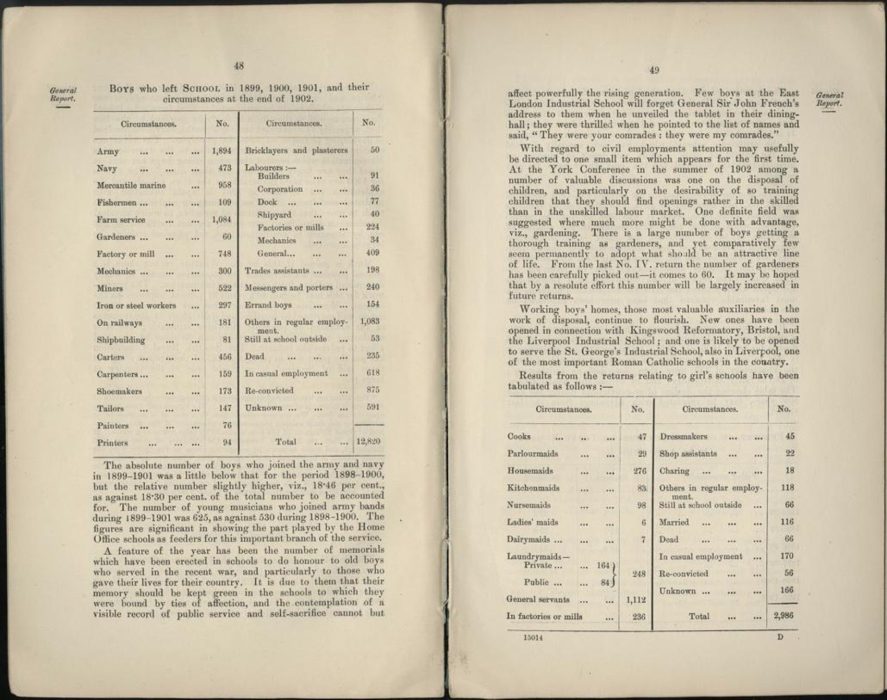Report of Reformatory Schools in Great Britain, 1902
Reference: NRO 00820/H/13
Suggested age groups: KS2, KS3, KS4, lifelong learners
Subject areas: History, Maths, Citizenship, Art, Design Technology
CONTEXT
At the beginning of the nineteenth century a child who committed a crime was tried in the same court as an adult. If the judge or magistrate sentenced them to prison, they would be sent to the same prison as adult criminals.
Some campaigners, such as Mary Carpenter, argued that children should be kept away from adult criminals so that they did not learn bad habits from them. She also said that children should be given training and be allowed to play.
Pressure from campaigners led to Parliament passing the Reformatory Schools Act in 1854. The Act allowed reformatory schools to be set up. Magistrates could send children under the age of 16 to these schools, instead of to prison.
A reformatory school was set up in Newcastle in 1853, just before the Act passed through Parliament. The school was moved to Netherton, near Morpeth, in 1857.
Reformatories and industrial schools collected information about the lives of the children that left their care. The discharge register at Netherton contains information about the boys for about three or four years after they left. The table in this report shows what happened to boys across the country when they left reformatories or industrial schools.
See also the discharge records of Isaac Cohen and Isaac Wilson.
ACTIVITIES
ACTIVITY 1
Background
Reformatories and industrial schools collected information about the lives of the children that left their care. The discharge register at Netherton contains information about the boys for about three or four years after they left. The table in this report shows what happened to boys across the country when they left reformatories or industrial schools.
SEE
See: What was the most common circumstance of boys who had left reform school?
See: What was the most common circumstance of girls who had left reform school?
See: What percentage of boys had been reconvicted in the time since they had left reform school?
See: What percentage of girls had been reconvicted in the time since they had left reform school?
THINK
Think: Why did reformatories keep track of the boys’ and girls’ circumstances after they had left the school?
Think: What can we learn about the effectiveness of reformatory schools from the report?
Think: What can you learn about the class level or personal backgrounds of the boys and girls based on the jobs that they took?
Think: What does this tell you about the types of people who went to reform school?
DO
Do: Create a pie chart showing the percentage of circumstances of boys and girls after leaving reform school.
Do: Research some of the boys from Netherton, along with other reformatory schools. Create a presentation showing how effective reform school was as a form of punishment and rehabilitation.
Resources
ACTIVITY 2
Background
At the beginning of the nineteenth century a child who committed a crime was tried in the same court as an adult. If the judge or magistrate sentenced them to prison, they would be sent to the same prison as adult criminals. Pressure from campaigners led to Parliament passing the Reformatory Schools Act in 1854. The Act allowed reformatory schools to be set up and for them to be officially inspected. Magistrates could send children under the age of 16 to these schools, instead of to prison.
SEE
See: How were child criminals tried and sentenced in the early nineteenth century?
See: Why did campaigners want to keep child criminals separate from adult criminals?
See: What did Mary Carpenter say children should be given, rather than being sent to prison with adults?
See: When was the Reformatory Schools Act passed?
See: Who could be sent to reformatory school?
THINK
Think: What were Mary Carpenter’s education principles and methods?
Think: How were Mary Carpenter’s education principles and methods different to the general principles of the time?
Think: What was the purpose of reformatory school?
Think: What were the conditions like in reformatory school?
Think: What were the rules and regulations of reformatory school?
Think: What would the children have spent their time doing at reformatory school?
DO
Do: In small groups, debate whether or not introducing reformatory schools was the right way to punish child criminals.
Do: Using the information provided by the Children’s Homes website, draw up a plan of Netherton.
Resources
OTHER ONLINE RESOURCES
The National Archives website, page on “Victorian Children in Trouble”: https://www.nationalarchives.gov.uk/education/resources/victorian-children-in-trouble/
Infed.org website, page about Mary Carpenter and her ideas about education:
https://infed.org/mobi/mary-carpenter-reformatory-schools-and-education/
Northumberland Archives blog, page about Netherton Reformatory:
https://northumberlandarchives.com/2015/03/30/netherton-reformatory-one-mans-first-world-war-story-david-eckstein/
Children’s Homes website, page with history of Netherton Reformatory:
http://childrenshomes.org.uk/NethertonRfy/
Children’s Homes website, page with general information about reformatories: http://childrenshomes.org.uk/Rfy/
Children’s Homes website, page with model rules and regulations (1890): http://childrenshomes.org.uk/rules/Rfy.shtml


